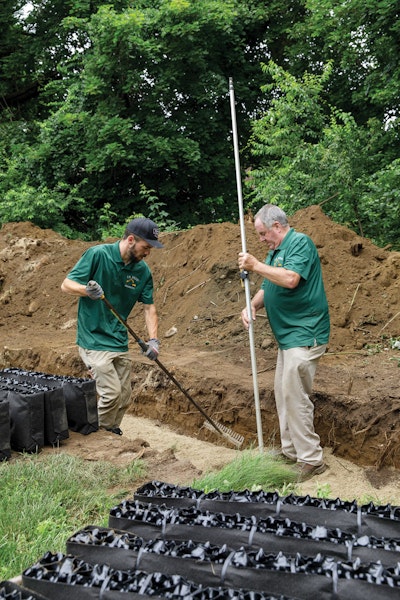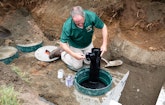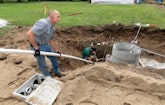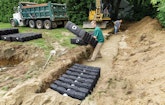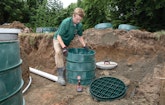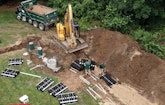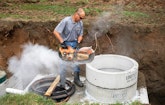Several years ago, Jay Daymon noticed a troubling trend in Connecticut’s onsite treatment world: Concrete septic tanks corroding and failing, some after just five to 10 years in the ground.
He could have just shrugged and kept on replacing tanks that crumbled prematurely. He could have pointed a finger at the tank manufacturers. Instead, he tackled the problem and came up with a solution that, so far, has proven effective.
It’s just one way in which Daymon, co-owner of T.M. Wright Excavating, works to deliver quality installations and excellent service to customers around Orange, in south-central Connecticut.
Daymon joined the 73-year-old company in 1977 and says that with strong connections with real estate agencies and homebuilders, as well as positive word-of-mouth recommendations, he’s needed little advertising or promotion to bring in business. In fact, during the COVID-19 pandemic, the company ran with a three-month backlog throughout 2020.
A change of course
Daymon’s father-in-law, Thomas Wright Sr., started the business in 1948 doing general excavation and at one time had nearly two-dozen employees. “About a year after I married his daughter [Becky], he asked me, ‘Would you ever think about the excavating business?’” Daymon explains, “I said, ‘I’ll tell you what. I’ll give it a year, and if you don’t like me or I don’t like you, then we’ll just part amicably.’ And he said, ‘Fine.’”
So Daymon left his job in security system sales and joined T.M. Wright Excavating. His father-in-law ran the business until he died in 2008; then Daymon and Becky became half-owners with her brother, Thomas Wright Jr.
The company started installing septic systems in the 1970s, and when Daymon came on board, “I really took to it. Back then it was a lot of the old guys doing it the way they had always done it. Everything was pipe and stone, and as long as you had the proper pitch on the pipes, the system probably would last forever.”
Today T.M. Wright specializes in septic system installation, repair and inspection while doing excavation, such as trenching for sewer and water lines and site work for new homes and additions. Daymon gravitated toward alternative drainfield materials, first with chambers (Infiltrator Water Technologies) and then other proprietary products:
1. S-Box lightweight media (Geomatrix Systems), serpentine cuspated mesh plastic inside a metal cage.
2. Mantis leaching systems (Eljen) also cuspated mesh plastic, in this case wrapped in filter fabric, with an encased distribution pipe. “It creates a biomat inside the unit, and eventually the effluent will leach out into the sand and into the surrounding soil,” says Daymon.
3. Ruck A Fin media (Innovative RUCK Systems), with material similar to S-Box and Mantis. “It’s like an accordion,” says Daymon. “You stake one end of it into the ground and stretch it out to 10 feet. You put a 2-inch distribution pipe on top of that with a tee into the cuspated mesh, and then backfilled with sand. It’s only 7 inches tall, so it gives you a lot of square footage in a low profile.”
The company also installs sand mounds and filled systems, which are similar to mounds except that the sand package is extended down-gradient. “In a filled system we remove the topsoil and then bring the bottom of the leaching field away from the restrictive layer, whether it be groundwater or ledge rock. The leaching field itself is up at the top, and everything wants to move down gradient. So by the time the effluent makes it to the bottom, it should be pretty pure even if it does come out of the ground, but normally it doesn’t.”
Installers in Connecticut use ASTM C33 sand shipped by barge to New Haven from Rhode Island or Cape Cod. Even in challenging site conditions, says Daymon, “If you throw enough sand at it, we can make a system work forever.”
Passion for design
Daymon refers to himself as “a walking code book. I’ve designed so many systems per year; that’s my fun part of the job, doing the soil testing, designing and implementing the jobs.”
Soil conditions vary considerably from site to site. “We have a lot of poor soils, and we also have some beautiful bank run gravel,” says Daymon. “In some places where it’s bank run gravel, there is no restrictive layer in the soil; no groundwater and no ledge. It’s home free for a septic system. It’s sand and stone. It came off the glacial wash. If you would pour a 5-gallon bucket of water into bank run gravel, it would just disappear in front of your eyes.”
More typically, sites will have a layer of good-quality topsoil over a B horizon of orange-brown fine sandy loam, and below that, glacial till. “Sometimes it’s porous and sometimes it’s silty and rock-hard, and usually that’s where the water table will start,” says Daymon. Groundwater depth varies from about 12 inches below grade on the most problematic lots to 36 inches down.
For site evaluations, Daymon uses an excavator to dig two or three deep test pits to locate the restrictive layer, followed by a traditional percolation test.
In addition to Daymon (president) and Thomas Wright Jr. (vice president and equipment operator), the company staff includes Becky Daymon (secretary and billing), Ray Holden (site layout, driver and operator), Cody Wright (driver, laborer and operator) and Tucker Wright (laborer and operator).
The equipment roster includes:
- Caterpillar 2007 312B and 2021 313F excavators
- John Deere 2005 650H bulldozer
- John Deere 2012 35D and 2016 35G excavators
- John Deere 2001 310SL backhoe/loader
- John Deere 2004 4410 tractor with 2003 Harley rake
- Dodge 2012 3500 utility truck and 5500 mason dump truck
- Two Peterbilt triaxle dump trucks and Eager Beavers trailer
Pandemic business boom
T.M. Wright needed all its expertise and resources after the COVID-19 pandemic hit. Business volume increased 70% from 2019 to 2020. “I’ve never seen it so busy,” says Daymon. “Normally we never have a backlog going into winter; usually by June or July it’s starting to slow down. But we had a three-month backlog all year long. The governor said, ‘Nobody’s going to work, you’re all staying home.’ So now mom, dad and the three kids are home all day long, and they’re using water almost 24/7.
“In the normal cycle mom and dad go to work, the kids go to school and the septic systems gets a rest eight hours every day. Now they’re not getting that rest. So people were blowing the septic systems out of the ground.”
On top of that was a boom in real estate as people moved to Connecticut to escape the virus hot spot of New York State. People were buying houses at upwards of 30% over the asking price. Many transaction-related septic system inspections revealed cracked tanks and other defects. Meanwhile, homebuilders were busy. In 2020 T.M. Wright installed 105 septic tanks and nearly 40 complete systems.
Leave customers happy
Keeping up with the spike in business didn’t mean cutting any corners on service quality, according to Daymon. “When we leave a job, the people are happy,” he says. “We guide them through it right from the beginning so they’re not afraid of what’s going to happen.
“We tell them we’re going to blow up their yard today, and tomorrow we’ll put it all back together, and all they have to do is wait for the grass to grow. We can install a system in a day. Once they see that everything is all smoothed out and see our guys putting the grass seed down, they are very happy about that.” When installing mounds and filled systems, crew members try to work with the site contours and make the system blend into the landscape.
Septic tanks, piping and all components are installed with meticulous care, Daymon says. Precast concrete tanks come from United Concrete in Wallingford, Connecticut. This is where T.M. Wright has been innovative in looking at corrosion prevention.
Conquering corrosion
“Corrosion in septic tanks is a huge concern in Connecticut,” Daymon says. The soils tend to be high in sulfur, and bacterial action during treatment of effluent generates hydrogen sulfide gas. Some of that gas backs up into the septic tank, and in that humid environment a mild sulfuric acid forms.
“It eats the cement portion of the tank right where the filter baffle is mounted to the wall,” says Daymon. “Some tanks were not lasting even five or 10 years, and we’d have to put a new one in. The gas attacks the Portland cement. You see the aggregate after a couple of years and then the tank just starts deteriorating.”
Daymon diagnosed the trouble as corrosive gas getting trapped inside the effluent filter screwed to the end wall of the tank: “The gas hangs out right there and just destroys the concrete. In response he devised a two-pronged solution.
First, when a new septic tank is delivered, he removes the factory-installed Polylok PL-122 4-inch filter and installs a Polylok PL-250 6-inch filter, not on the end wall but glued onto the distribution pipe, away from the wall, beneath the concrete outlet inspection cover.
“Now the gas comes up, and the only way it can go is vertical, up through that 6-inch filter,” says Daymon. “The inspection cover, which is concrete, will deteriorate and corrode, but for $30, you can buy a new cover.” As the second step in the remedy, he sprays tank end wall and the underside of the cover with Flex Seal sealant (Flex Seal Products).
“I’ve been doing this for three years, and now the pumpers in the area are saying, ‘Jay, your system is working.’ I’ve talked to state regulators and some sanitarians, and they’re impressed with what we’re doing.”
Congenial relationships
Daymon’s business prospers in an area where his father-in-law’s name is well known: “Tom Wright grew up in the town and knew every single person. His family was one of the founding families in the town. The property where my office is, the homestead farm, was granted to the family by King George before the Revolution. So that’s pretty special.”
On the marketing side, Daymon is a member of the Orange Chamber of Commerce, through which he makes valuable connections with other businesspeople. He promotes mainly by way of lawn signs on job sites and ads in the guidebook for a country fair that is a popular annual attraction.
There are only a few competing installers in the towns where T.M. Wright works, and for the most part they get along well and help each other: “I was on a job, and across the street there was another contractor. He came over and said, ‘Jay, can I borrow your backhoe for a minute? I forgot to crush the tank in the front of the house and I don’t want to bring the crawler machine all the way around.’ I said, ‘Sure, come on over and get it.’”
When he needs a septic tank pumped for an inspection, Daymon calls Tom Hill Septic Services, whose owner is a close friend. Onsite professionals also work together on community events, like volunteering at county fair tractor pulls.
For professional development, Daymon is a 30-year member of the Connecticut Onsite Wastewater Recycling Association: “I’ve been to a couple of their dinners. I’ve been to soils training classes they sponsor. That has been really helpful. I’ll do whatever it takes to learn. I read everything. My wife says I’m like a sponge. I just absorb it all.”
